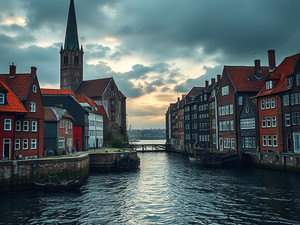Ruderne: A Deep Dive into Denmark’s Iconic Landmarks and Cultural Heritage

When you hear “ruderne,” the first image that likely pops into your head is of those towering, wind-swept masts dotting the Danish coast. But these structures are far more than just maritime navigational aids—they’re emblematic of Denmark’s rich history, ingenuity, and connection to the sea. In this article, we’ll explore everything there is to know about rudeerne, from their historical origins to their modern-day significance, offering a comprehensive guide for enthusiasts, travelers, and history buffs alike.
What Exactly Are Ruderne? A Clear Explanation
At their core, ruderne are traditional Danish maritime navigation aids—tall, often brightly painted masts or poles used to mark channels, harbor entrances, or hazards to shipping. Their design varies across regions but generally features a sturdy wooden or metal pole topped with navigational markers, lights, or signals. These structures have been a staple along Danish coasts for centuries, serving as visual cues for sailors navigating tricky waters.
Historically, rudeerne played a vital role before the advent of modern GPS technology. Sailors relied heavily on such visual markers, especially in foggy or stormy conditions when electronic systems could fail. Their strategic placement helped prevent shipwrecks and facilitated trade, making them essential to Denmark’s maritime economy.
Today, rudeerne have transitioned from purely functional structures to cultural landmarks—some are preserved as historical monuments, while others continue to serve navigational purposes. They symbolize Denmark’s enduring relationship with the sea, embodying resilience, tradition, and maritime pride.
The Historical Roots and Evolution of Ruderne
Origins in Danish Maritime History
The origins of ruderne trace back to medieval Denmark, a nation with a long-standing relationship with seafaring. During the Middle Ages, as trade routes expanded and ships grew larger, the need for reliable navigation markers intensified. Early rudeerne were simple wooden poles or flags placed at critical points near harbors and along coastlines.
During the 17th and 18th centuries, as Denmark’s naval power and merchant fleet grew, so did the sophistication of rudeerne. They began incorporating lights, lanterns, and increasingly elaborate signaling devices, which made navigation safer and more efficient. These structures became iconic features along the Danish coasts, especially around major ports like Copenhagen, Aarhus, and Frederikshavn.
Evolution into Modern Times
With technological advancements, particularly the introduction of radar and GPS in the 20th century, the reliance on ruderne diminished. However, many were preserved as part of Denmark’s cultural heritage, and some still serve practical purposes today. Modern rudeerne often incorporate solar-powered lights and electronic signals, blending tradition with innovation.
Interestingly, certain regions have revived the use of traditional rudeerne for aesthetic and tourist appeal. They now serve as scenic landmarks that attract photographers, history enthusiasts, and travelers eager to experience Denmark’s maritime legacy firsthand.
| Era | Key Developments | Significance |
|---|---|---|
| Medieval Times | Wooden poles, basic signaling | Foundation of maritime navigation |
| 17th-18th Century | Incorporation of lights, flags | Enhanced safety, facilitated trade |
| 20th Century | Introduction of radar, GPS; decline in reliance | Transition to modern navigation technology |
| Present Day | Preservation, tourism, hybrid signaling systems | Cultural heritage, scenic landmarks |
The Cultural and Symbolic Significance of Ruderne in Denmark
Beyond their functional role, ruderne hold a special place in Danish culture. They symbolize resilience, independence, and the country’s deep connection to the sea. For many Danes, these structures evoke nostalgia and pride, serving as reminders of a maritime era that shaped national identity.
Ruderne as Cultural Landmarks
In recent years, several rudeerne have been declared protected monuments, recognized for their historical value. For example, the famous Ruderen at Skagen, often called Denmark’s most iconic, stands as a testament to the country’s seafaring history. These landmarks are often featured in local art, literature, and festivals, reinforcing their cultural importance.
Tourist Attractions and Photographic Gems
Today, ruderne draw thousands of visitors each year. Photographers flock to capture their striking silhouettes against sunrise or sunset, while history enthusiasts explore their stories. Coastal towns often host festivals celebrating maritime heritage, with rudeerne serving as focal points.
Environmental and Conservation Aspects
As climate change accelerates sea level rise and weather patterns become more volatile, some ruderne face threats of erosion or destruction. Conservation efforts are ongoing to preserve these structures for future generations, emphasizing their importance as part of Denmark’s national heritage.
The Different Types of Ruderne Across Danish Coastlines
No two ruderne are exactly alike. Their design and function vary depending on regional needs, local maritime conditions, and historical periods. Here’s a quick overview of the most common types:
Traditional Wooden Ruderne
Most ruderne are made of durable wood, often pine or oak, crafted to withstand harsh weather. They feature a simple pole topped with a flag, lantern, or light. These are prevalent along the west coast and in less urbanized areas.
Modern Metal and Composite Ruderne
In more developed ports, ruderne have evolved into metal structures fitted with modern lighting systems, solar panels, and electronic signals. They’re designed for longevity and minimal maintenance.
Unique Regional Variations
- Skagen Ruderne: Known for their distinctive red and white stripes, these serve as both navigational aids and cultural symbols.
- Jutland Rudeerne: Often taller and more robust, built to withstand rougher seas.
- Fjord Rudeerne: Smaller, more decorative, often used in sheltered waters for aesthetic purposes.
| Type | Materials | Typical Location | Key Features |
|---|---|---|---|
| Wooden Ruderne | Pine, oak | Coastal villages, less urban | Classic design, traditional look |
| Metal/Composite Rudeerne | Steel, fiberglass, solar panels | Major ports, modern areas | Durable, illuminated, eco-friendly |
| Decorative Rudeerne | Wood, painted wood | Fjords, tourist spots | Aesthetic, sometimes non-navigational |
The Future of Ruderne: Preservation and Innovation
Looking ahead, ruderne stand at a crossroads between preservation and modernization. Their historical role is undeniable, but they also need to adapt to contemporary maritime needs and environmental challenges.
Preservation Efforts
Organizations like the Danish Agency for Culture and Palaces actively work to conserve ruderne, especially those with historical significance. Restoration projects often involve local communities, emphasizing these structures’ importance to cultural identity.
Incorporating Technology
Innovative approaches are being implemented to ensure ruderne remain functional and sustainable. Solar-powered lights, GPS integration, and automated signaling systems are examples of how tradition meets modernity—ensuring navigation safety while respecting heritage.
Community Engagement and Tourism
Communities are increasingly leveraging ruderne for tourism, offering boat tours, guided walks, and photo excursions. These initiatives not only boost local economies but also foster appreciation for maritime history.
| Challenges | Opportunities |
|---|---|
| Climate change, erosion | Restoration projects, resilient design |
| Technological obsolescence | Modern upgrades, smart signaling systems |
| Maintaining cultural relevance | Festivals, educational programs |
Wrapping It All Up: Why Ruderne Matter More Than You Think
In essence, ruderne are much more than simple navigational markers—they are living symbols of Denmark’s seafaring spirit. They tell stories of old voyages, economic growth, and cultural pride. Their preservation is crucial, not just for historical accuracy but for maintaining connections to a maritime heritage that continues to shape modern Denmark.
Whether you’re a history enthusiast, a traveler seeking scenic views, or someone interested in maritime innovations, ruderne offer a fascinating glimpse into Denmark’s coastal life. As they stand tall against the ever-changing sea, they remind us of the enduring strength and resilience of the Danish people.
FAQs About Ruderne
Q1: Are all ruderne still used for navigation today?
Most rudeerne have been replaced by modern electronic systems, but some still serve navigational purposes, especially in less-developed or protected waters.
Q2: Can I visit or see ruderne easily?
Absolutely! Many are accessible via coastal walks, boat tours, or from scenic viewpoints. Some are located within protected areas, so check local guidelines before visiting.
Q3: Are ruderne only in Denmark?
While ruderne are most iconic in Denmark, similar structures can be found in other Scandinavian countries and along northern European coasts, reflecting a shared maritime culture.
Q4: How are ruderne preserved?
Through government initiatives, local community efforts, and conservation organizations, many ruderne are restored and protected as part of Denmark’s cultural heritage.
Q5: Why are some ruderne painted in bright colors?
Bright colors like red, white, or yellow enhance visibility during foggy or stormy weather, ensuring they serve their navigational purpose effectively.
Final Thoughts
Ruderne stand as enduring symbols of Denmark’s maritime legacy—sturdy, beautiful, and steeped in history. As they continue to evolve, balancing preservation with innovation, they remind us of the importance of respecting our past while embracing the future. Next time you find yourself along Denmark’s coast, take a moment to appreciate these silent sentinels—they’re more than just poles; they’re storytellers of a seafaring nation.



